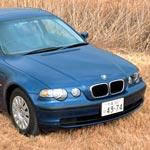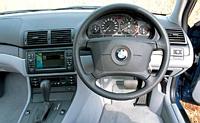 |
Special From Japan Today:
For fast-trackin' junior executives or value-conscious purveyors of luxury, BMW's smallest delivers the company's usual standards of quality and driving flair. Marish Mackowiak tightens his belt.
All-new taillights help give the 316ti a distinctive identity
BMW's new 316ti may be the runt of the 3-series litter, but it can handle curves like the big boys. With its abbreviated body, small engine and affordable price, this compact model stands apart from other 3-series sedans. Although it retains the basic 3-series look, the 316ti has an identity all its own. it doesn't share any panels found on its larger four-door siblings. Separated round headlights are one of the 316ti's most distinctive features, and its taillights, with their clear covers, are more reminiscent of those on Toyota's Altezza than anything currently available from Bavaria. Also, a fin that mysteriously sticks out from the roof is actually a telephone antenna. But that's where the differences end. Like the previous model, the abbreviated trunk makes this Beemer immediately recognizable as a 316, although the appeal is more cheeky and cute than sleek and rakish, and star-design hubcaps mimic the latest BMW alloys.
Beemer benefits
Despite being an entry-level model, the roundel on the steering wheel boss remains the semiotic code for bulletproof BMW quality. While this Beemer lacks some of the luxuries found on pricier models, the 316 exudes quality—with the exception of the plastic center console around the hand brake. Most of the usual 3-series interior has been retained, and there is an extensive list of extras designed to coax additional yen from okane mochi (rich) customers.
BMW dash—simple but not cheap
Although the plain gray interior, black dash and center console gave the test car an austere look, the "Young Line" décor pack, featuring a choice of bright glossy red or blue interior trim panels, is available to add flair. The smallest Beemer also boasts the usual high standard of ergonomics. The driving position can be adjusted for any frame, and there's plenty of room for even the tallest individuals in the front. In addition, the steering wheel is adjustable for both reach and rake to ensure a perfect fit. For a smallish car, the rear is not bad either—at worst, lanky drivers may need to splay their legs. Being a hatchback, the 316ti's rear seats fold down to create a large 1,100-liter storage area for camping or that double-income shopping spree. Despite being at the less-expensive end of BMW's range, the test car was fitted with a few little luxuries. The gear lever and park brake were leather-covered, though this doesn't extend to the steering wheel. An increasingly common optional DVD-driven audio/navigation/TV unit neatly filled a gap in the center console, replacing the standard radio/MD player. A glass-panel sunroof was another extra-cost feature. Regardless of price, it's safety first these days and the full array of front, side and head airbags are standard.
Small is beautiful—and more fun to drive As high-tech automotive extras expand at an exponential rate, cars have been packing on the kilos. Although horsepower has followed suit, many hefty vehicles are lacking that fun-to-drive factor. But BMW put the 316ti on an automotive diet—although it's still bigger than the previous compact models—with an aluminum chassis alone making it 20 percent lighter. As a result, and despite its small engine, the 316ti is enjoyable to drive, and encourages the driver to throw it into corners. The use of anti-roll bars at both ends, together with 50/50 weight distribution, inspires confidence. Cornering Brake Control and Automatic Stability Control keep the tires securely on the blacktop.
Power comes from a 1,796cc, four-cylinder, fuel-injected DOHC engine. It features BMW's "Valvetronic" (infinitely variable intake valve lift adjustment) and "double Vanos" (infinitely variable intake-outlet valve timing adjustment), giving the 316ti more power and better fuel economy—7.6 liters per 100km. Both are new technologies, with Valvetronic doing away with the traditional throttle butterfly. Despite putting out only 85kw/115ps at 5,500 rpm and 175N.m/17.8kgm of torque at 3,750rpm, the 316ti nevertheless feels quite lively. The 105kw two-liter donk in the 318ti is no doubt even better, while a sensational top-of-the-range six-cylinder 325ti belting out 141kw is available in other markets. The willing engine helps disguise the fact that the 316ti still weighs a relatively plump 1,370kg, despite its abbreviated dimensions. Another element that makes gives the 316ti pizazz is the new Steptronic (manual mode) five-speed auto, which enables the driver to change up and down with a flick of the wrist. In reality, the system holds the car in one gear for as long as possible, maximizing available power. It helps push the little Beemer to a screaming 7,000rpm, well past the 6,000rpm redline. Mysteriously, five-speed manual transmission is only available on the larger-capacity 318ti, which perhaps needs it less.
The 316ti is certainly no base model cheapie. It's a quality alternative for BMW fans who rarely drive with more than one passenger and don't need a full-size sedan. It's also an accessible way for lovers of automotive luxury to join the BMW club. Priced from ¥2,998,000, it's substantially cheaper than the lowest-priced Mercedes three-box sedans. The company's usual standard of finish and packaging, along with spirited performance, has resulted in a vehicle that seems perfectly suited to a fast-changing marketplace and value-conscious consumers.
Photos: Marish Mackowiak




